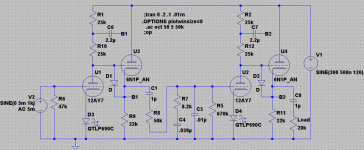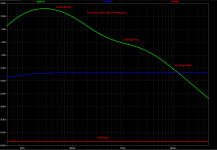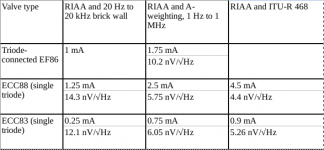Hmmm... as I diddled with that circuit more it appears that I can use 12AY7s in both locations and still have adequate gain. So far however I have only been able to get bass output up to 15dB above the 1Khz level (IIRC it should be 20dB) but the mid band gain is about 45dB which should be about right for MM I think. 10KHz is within 1dB of spec at -12dB.
BTW, I did run some PSRR simulations using the original AX7-AY7 circuit. I applied a PS with 1mV of 120 hz ripple (actually a sine wave). Input signal was 5mV. I ran the circuit both with the bootstrap connected and disconnected. I ran an FFT on the resulting 1kHz sine wave output. Since output level also changed I compared the difference between the fundamental and the 120 hz noise for both cases. The bootstrap did improve the ratio slighty being about 3dB better with the bootstrap.
I also ran a simulation of a 6SN7 linestage with similar loading and that looks promising.
BTW, I did run some PSRR simulations using the original AX7-AY7 circuit. I applied a PS with 1mV of 120 hz ripple (actually a sine wave). Input signal was 5mV. I ran the circuit both with the bootstrap connected and disconnected. I ran an FFT on the resulting 1kHz sine wave output. Since output level also changed I compared the difference between the fundamental and the 120 hz noise for both cases. The bootstrap did improve the ratio slighty being about 3dB better with the bootstrap.
I also ran a simulation of a 6SN7 linestage with similar loading and that looks promising.
Attachments
Thank you.
So to minimize noise contribution we want highish gm for the followers.
Noise wise it is mainly the gm of the input stage that matters, and also the 1/f noise of the input stage.
For amplifiers with RIAA correction, I once came up with this table for the optimal anode currents. The ECC83 (12AX7) and ECC88 (6DJ8) values are based on Merlin Blencowe's data, the triode-connected EF86 (6267) figures on my own measurements. The noise densities are white noise densities that would result in the same integrated weighted noise as the actual noise of the triode.
I never thought about amplifiers for ceramic cartridges with less or no correction.
Attachments
Last edited:
Of the various standard weightings, ITU-R 468 best matches what you hear, unweighted is the worst match and A-weighted is somewhere in between.
Regarding your second question, to me Merlin's article is very clear, but I'm a hobbyist as well as an electronics engineer. Maybe you can first check if you can follow the discussion in this thread about his article: Flicker Noise dominates triode noise in audio (AES)
Regarding your second question, to me Merlin's article is very clear, but I'm a hobbyist as well as an electronics engineer. Maybe you can first check if you can follow the discussion in this thread about his article: Flicker Noise dominates triode noise in audio (AES)
- Status
- This old topic is closed. If you want to reopen this topic, contact a moderator using the "Report Post" button.


